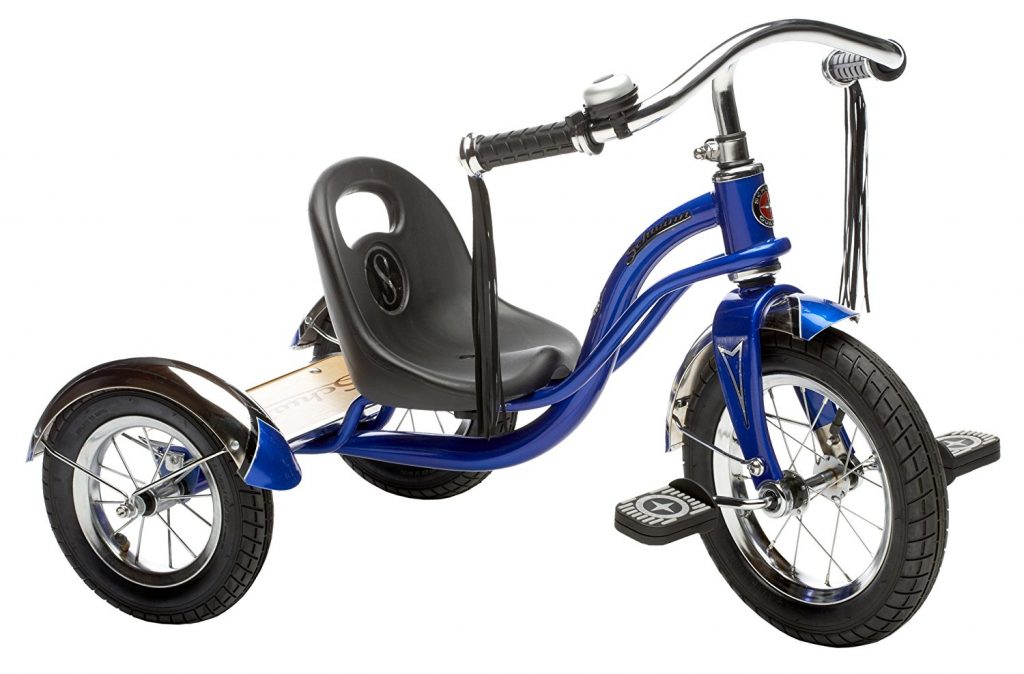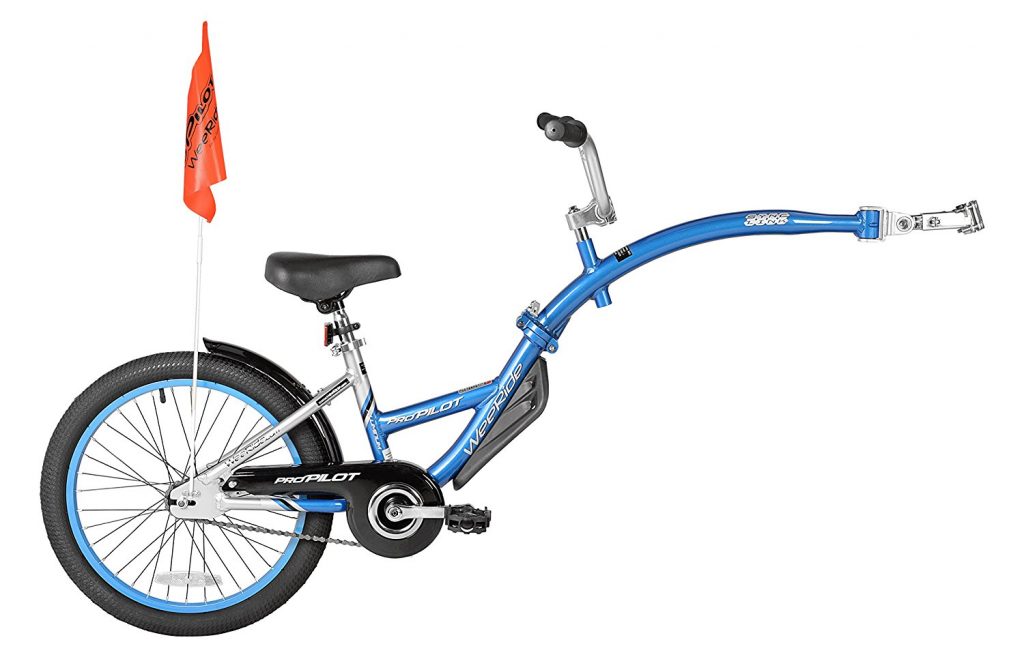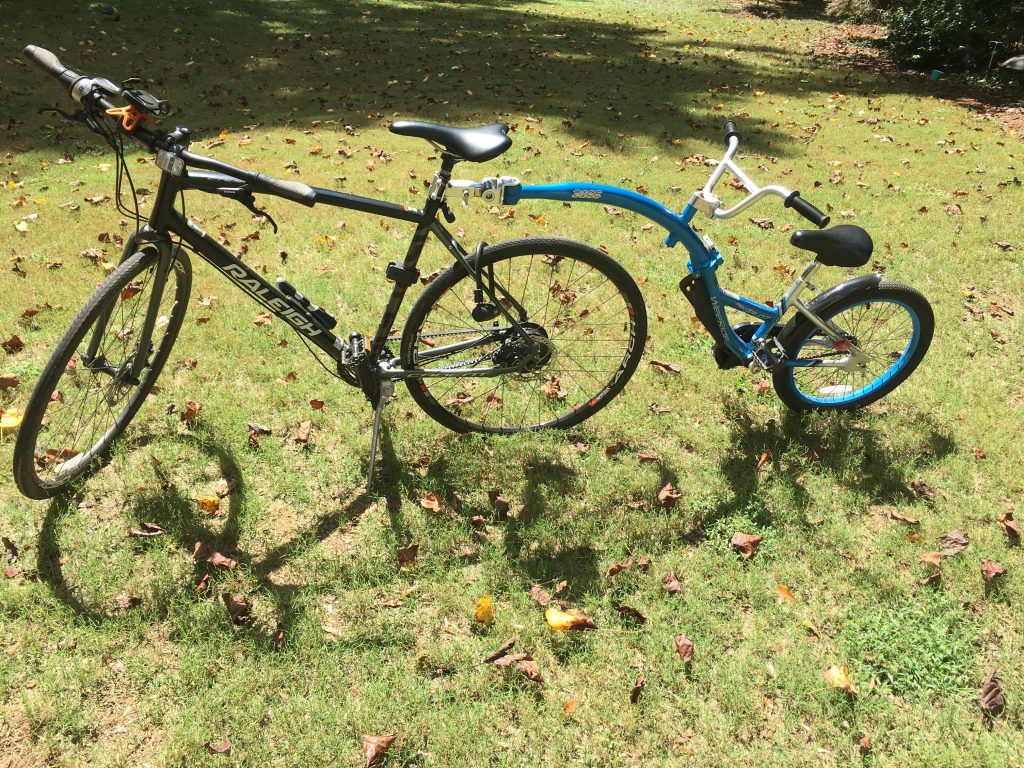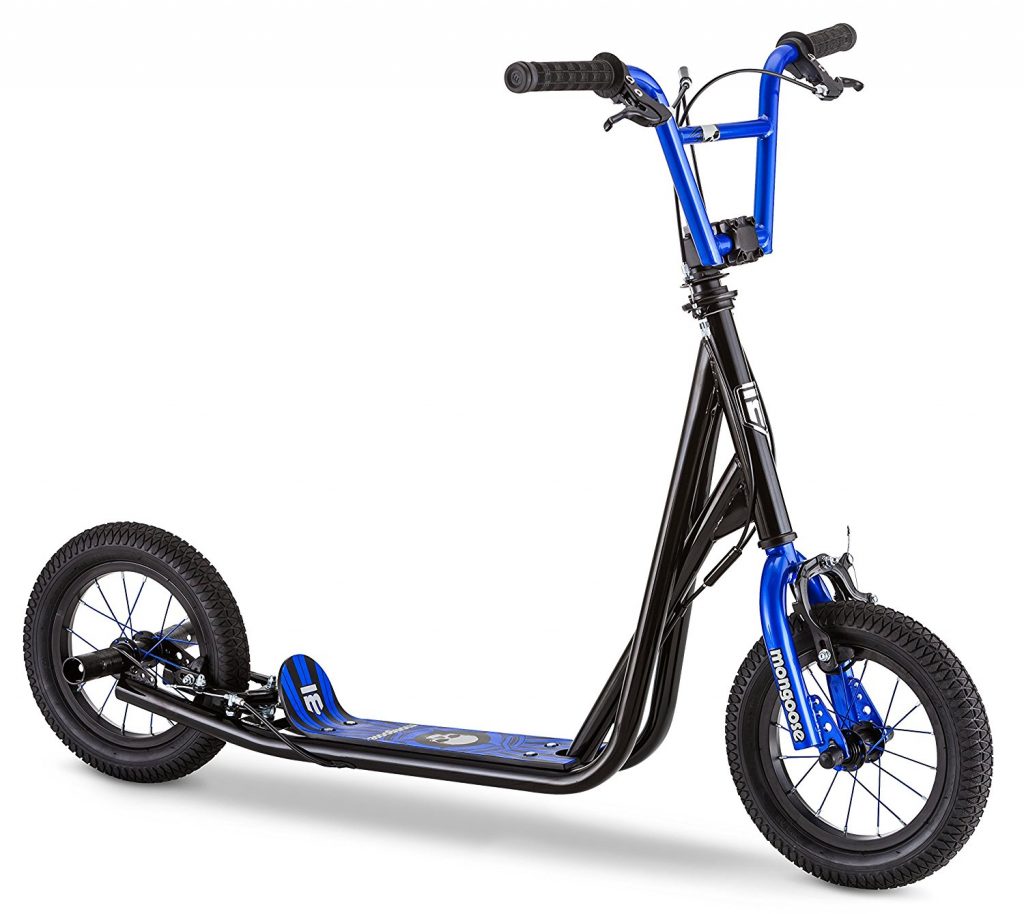This is a very long read about our journey to riding a bicycle. We’re not there yet, but we’re getting really close.
****
UPDATE: February 13, see our clip from her successful outing on her bike!! So proud!
****
Long before we had ever heard the word “dyspraxia” or knew what it was, we had already started to make accommodations for our daughter because of the challenges we observed. You probably have too.
When she was 2 years old, her relatives gave her a balance bike for her birthday. We were really, really excited about that!
We had considered getting one and wanted her to be able to hop on a bike or a tricycle as soon as possible because it offers so much fun, mobility, and independence for kids.
It took a little while for her to grow tall enough for the balance bike, and when she did, all she would do is walk it around the house while sitting on it. If you attempted to put her on it and use it outside she got really upset about it if you didn’t do all of the work. She didn’t feel safe at all. As for doing the Flintstone peddle walk and then coasting along – fah’get about it! Wasn’t happening.
We didn’t know why it wasn’t working. But we didn’t give up.
So we bought a tricycle for her third birthday. It fit her, and it was low to the ground, so it felt safe. For a child who is struggling to make a tricycle work, there are some really good points about a tricycle like this one.
First, the wheels are air filled tires which makes the ride smoother, and allows you to roll over small obstacles more easily. Second, it’s low to the ground and the seat supports the back so balance is not a problem. We didn’t have a name for what we were dealing with (Dyspraxia), but we knew that a backless seat would not work. She didn’t have the upper body strength.
Behold, the Schwinn Roadster Tricycle / Trike with 12″ wheels. Here’s a shiny picture:

At first, we mostly pushed her because she couldn’t peddle. No, we didn’t want to do that, but it was that or nothing. We didn’t realize that we were asking way more than she was capable of – peddling, steering, holding her body just so, stiff arms, upper body strength. We just assumed that we needed to keep working and pushing her muscles because that’s what everyone had told us. We just assumed she wasn’t really trying.
When you step back and think about it, what kid doesn’t want to succeed at being mobile on their own? None, that’s how many.
Eventually, she mastered the tricycle, but as soon as she could pedal and (mostly) steer on her own, she was too big for it. That was right around age 4. She was doing it and feeling pretty good about it, but she was really getting too big for the Roadster and her knees would hit the handle bars.
On to the next step. Let’s make it a big one!
A few months after her fourth birthday, when she started Pre-K, I wanted to bike to school with my daughter. I had seen some parents and kids on tandem bikes and it looked very doable and it looked like a lot of fun. So I purchased this thing – the WeeRide Tandem Bike (about $129 at Amazon):

I initially hooked it to my 1998 vintage mountain bike which needed (and still does) a complete overhaul. But it could still be ridden, so why not. I didn’t have the hitch bolted on very tight so the WeeRide was a bit loose. Initially she loved it. Then after about 20 seconds, she didn’t. She suddenly started crying and screaming and saying that it made her hungry. Huh? Hungry? Ah, butterflies! Stomach butterflies aren’t necessarily good for some kids.
But this was just a test of the concept, and I already had two things on order to salvage the situation so I didn’t write it off.
The first was a bike mounted toddler seat – the kind you see most parents using on a bike to carry a baby. However at age 4, it didn’t have a lot of life left before she would outgrow it. As in, it was really already too small. I knew that. It was simply a 30 day bridge to the next phase – the WeeRide Tandem shown above. (A couple of months later, once she was in love with the WeeRide, I sold the carrier seat and the net cost to me was about $20 – well worth the confidence it gave her to be on a bike with me.)
The second thing I had on order was a new bike for me. Might sound crazy, but I really didn’t want to use the old bike in this case for lots of reasons, the biggest one was sound. The old bike made lots of noise, including a ping drop sound in the crank which was too close to a high pitch sound that my daughter is very sensitive to.
I had wanted a newer, lighter bike for a while, something appropriate for the road to just cruise around.
There were three reasons I picked the Raleigh Cadent i8 – which is no longer sold, sadly. In fact it appears that Raleigh no longer sells belt drives on their bikes. That’s a shame because it’s a solid, proven technology, and they are amazing to ride. (Check out Priority Bicycles for a belt driven 20″ bike for kids over 5 or 6 and they have adult bikes too!)
So, three reasons for this new bike which turned out to be a very smart choice for us:
The first is disk brakes. I wanted the most stopping power I could get on wet and dry roads when towing my daughter. I didn’t plan on setting out in the rain, but I knew if we were ever in rain, the disc brakes would matter. For a child with neurodiversity, one accident is all it takes to permanently block out an activity for years!
Second – the belt drive! I’ve tinkered with bikes since I was a kid, but mostly, I’m no longer interested in doing that. And I have not forgotten the chain oil on my hands and clothes. The belt drive solves that problem. It doesn’t loosen over time, it can be adjusted for the tension setting you want and it’s zero maintenance.
Third – the NuVinici 380 CVP hub which is now marketed through Enviolo.
TL;DR: this crazy thing: Enviolo NuVinci CVP Hub
It’s a gearless transmission hub with a decent gearing ratio. The shop I used was able to swap out the internally geared Alfine hub on the Raleigh Cadent i8and put the NuVinci in it’s place.
The result is completely silent and smooth shifting. No one even knows when you shift. And for a child who has sensitivity to sounds, bumps, etc., that was, and continues to be, amazing!
We took the tandem rig out to the Silver Comet bike path on the west side of Atlanta and she was on the moon after just 10 feet of cycling. SUCCESS!
Here is the complete tandem rig:

So, let’s recap:
- Balance bike – age 2 to 3 – no go.
- Tricycle – age 3 to 4 – yes, with about a year of work and lot’s of encouragement.
- Tandem bike – age 4 – SUCCESS!
Now we’re getting somewhere.
Meanwhile we’re seeing 4 year olds on balance bikes roaring down hills and 4 and 5 year olds on 12 and 14 inch pedal bikes with and without training wheels. But hey, this is how it goes. Not only would that be normal for ANY child, it’s very common with dyspraxia. That we were on a tandem bike at age 4 – wow!
So what now? Scooting time!
At about 5 and 1/2 years old, some friends gave us an old Razor scooter. Our daughter was STOKED! She so much wanted to ride that.
As with the tricycle, it has taken 9-10 months to reach a level of success. The problem is both dyspraxia and the scooter itself.
Stop and think about all the things you have to do – without thinking – when riding on a scooter:
- Balance
- Stiff arms, but bent elbows for flexing and absorbing shocks
- Stiff legs, but bent knees for flexing and absorbing shocks
- One foot on, one foot kicking along the road
- Kicking foot prepared to brake
- Steer the scooter
- Resist the urge to flee
Think about it from the point of view of someone with motor planning and coordination problems. It’s a heck of a challenge. Even when we tried a three wheel scooter it did not help with the underlying issues of muscle tone and balance, nor with limb coordination and visual tracking. The head and arms aren’t working in tandem to steer the scooter.
After 9-10 months, she has been able to balance and roll down a gentle slope for 20-30 feet and then also brake. That’s pretty darn good! No, that’s pretty damn good!
But, the problem with the razor is that the wheels are small and hard and the steering has no feedback. So, the tiniest twig or pebble will stop the front wheel and cause the handle bars to turn sideways because the muscle strength to hold the handle bars is lacking. Visual tracking is not keeping up with the scooter and the arms aren’t responding when vision is keeping up, so the result is that she refuses to gather any speed which is needed to keep the scooter balanced. It’s a bit of a catch 22.
Riding a scooter is not an age inappropriate activity! It only looks that way until you put several same age kids together and then notice how easy it is for someone without the challenge of dyspraxia. Then you realize the challenge.
So after 9-10 months on the Razor, we’ve reached a blocking point where no more progress can be made on that particular device at this time. The visual tracking difficulties, low muscle tone in the arms, and fear, due to the inherit limitations in a Razor, have effectively capped the progress we can make on that device – for now.
Time to transition what she has committed to long term memory to another device.
So, we purchased this beast off of (you guessed it) Amazon, for about $79:
Behold, the Mongoose Expo Scooter

Think this is too big? Too much? Too hard? Think again.
With dyspraxia you are trying to solve a puzzle. How do you assemble the pieces correctly to reach a goal? What tools do you need? The steps may not be (and likely aren’t) sequential.
Understand, our goal is not biking per se – it’s to be able to share an independent activity with a friend at an appropriate age. Biking is one such activity.
Even now, in first grade, there is still a lot of variance in capabilities. No, lot’s of kids can’t ride bicycles. We get it. But, most kids CAN do all of the individual skills required to ride a bike. They only have to overcome their fear. A child with dyspraxia has to overcome fear and manage all of the required skills.
You will never have parity with your child’s peers all of the time on all things. What you can do is aim for milestones at the appropriate time. If you reach some common milestones, your child will know that they can do some of the things that their friends can do. And they will have a feeling of success and accomplishment and they will continue to reach for their goals!
OK. So, the Mongoose…
- Big air filled 12″ tires – rolls over just about anything
- Heavy – provides resistance when rolling, builds muscles when kicking
- Larger – feels larger to the child and they perceive it as safer than a razor.
- Hand brakes.
- An adult can ride along, carefully to actually make it work.
- Can experience speed safely
If your goal is for your child with dyspraxia to be able to ride a bicycle at say, age 7, not only does she have to master all the skills which her peers would master in much less time, but you, her parents, HAVE to know that she can do it safely, without crashing every time she hops on the bike.
And so here is an example of how the safety part plays out in real life for a child with dyspraxia – why you do or do not spend time learning certain things:
With the WeeRide tandem bike, our daughter can peddle backwards for fun because it doesn’t have a coaster brake – that’s the brake that engages when you peddle backward. So, it’s just like a big kid bike. For those of you with fond memories of a coaster brake, you might be sad to know that it’s being phased out in lot’s of other countries, but for good reason – coaster brakes make no sense! Why should peddling backward be a proper way to stop? You also cannot stop the front wheel. And so, a rider has to transition to hand brakes around the time that they move up to a 20″ bike – say age 7 or 8. So, why learn a skill that you don’t really need?
To be more precise – do you want to waste the valuable time you have working with your dyspraxic child teaching them to unlearn a coaster brake? No. You do not!
Dyspraxia does not affect long term memory, it’s the working memory and short term memory where kids have trouble, until they learn to compensate with organizational habits. Skills and habits which have been committed to long term memory are cemented in place.
You do NOT want to commit coaster brakes to long term memory, only to have your child try to engage a non existent coaster brake a year later while rolling down a hill.
Helping a child with dyspraxia learn to ride a bike is going to be hard – don’t waste time with coaster brakes unless it absolutely has to be done to accomplish the task.
The mongoose scooter has hand brakes. So, she will learn braking from the beginning the way it is supposed to be done and the way it will be on her future bike – that will be committed to long term memory. At the moment, her hands are not strong enough to squeeze the brake. But it will happen. And just for comparison, her 5 year old neighbor can totally squeeze the brakes, so again, this is not age inappropriate, it’s just more difficult with dyspraxia.
After one week riding tandem with me on the Mongoose, her duration on the Razor increased from just 20-30 feet to over 100 feet! That’s success!
So where do we stand now?
- Balance bike – age 2 to 3 – no go.
- Tricycle – age 3 to 4 – yes, with about a year of work and lot’s of encouragement.
- Tandem bike – age 4 to present – SUCCESS!
- Razor scooter – age 5 to 6 – (9-10 month learning period) – mostly successful.
- Large tire scooter – age 6 to 7 – partial success with adult riding along – but not yet braking.
Now, brace yourself because there is one more really impossible goal we are working on – Roller blading!
Yeah, you read that correctly. Roller blading.
If you haven’t figured it out by now, you soon will – you are going to spend the same amount of effort, time, frustration, blood, sweat and tears helping your dyspraxic child learn an exactly age appropriate activity as you will learning an activity that is ABOVE their age level. That means you don’t set the bar where it should be now – you set it where it needs to be in a year. And then you work the steps to that goal.
A few months ago when our daughter was still 5, she was playing with some kids who were only a few years older, but they had roller skates. And our daughter wanted to try them. It was much more successful than we thought it would be because a 9 year old was helping her and she wanted to impress! And after that, she wanted roller skates. And if you also haven’t figured this out yet – embrace your child’s goals if you want to see growth no matter how impossible!
At the same time, we noticed another 5 year old girl in the neighborhood on roller blades. Unusual, yes. But it’s possible. Our thinking was safety first in deciding against roller skates. The reason is that the wheels can become a trip hazard if they get too close to each other – a real possibility with dyspraxia. In fact, it’s not just possible – it’s going to happen with dyspraxia.
So yeah, we got roller blades instead because the wheels cannot lock up with each other if the feet are too close. And you know what, we have to help A LOT! But she can do it. And she can roll 20-30 feet on a smooth surface without help as long as you can launch her and catch her. Will she roller blade on her own this year? Nope. In 6 months? Probably not. But she will have started the path. More importantly, it’s helping prepare her for the objective – riding her bike with a friend one day soon.
So one more run down:
- Balance bike – age 2 to 3 – no go.
- Tricycle – age 3 to 4 – yes, with about a year of work and lot’s of encouragement.
- Tandem bike – age 4 to present – SUCCESS!
- Razor scooter – age 5 to 6 – (9-10 month learning period) – mostly successful.
- Large tire scooter – age 6 to 7 – partial success with adult riding along.
- Roller blades – age 6+ – with lots of adult help – yes, a little.
And what does this all mean for bicycling?
It means she has learned:
- …how to pedal (on a tandem bike)
- …how to hold the handle bars (on two styles of scooters) and on her tandem bike
- …how to work hand brakes
- …how to balance
- …how to stear
- …how to self power (on scooters and on roller blades and assist on a tandem bike)
- …how to shift weight for stability
- …how to use speed for stability
- …how to face common fears
And hopefully, later this fall, or next spring, when her hands are stronger and she is ready – I will have to pedal harder to catch up to her on her very own bike!
That will be success!
Your milage may vary. You may not need to do all of this. Or, maybe, none of this will work. Welcome to dyspraxia! Love, understanding, intervention.
